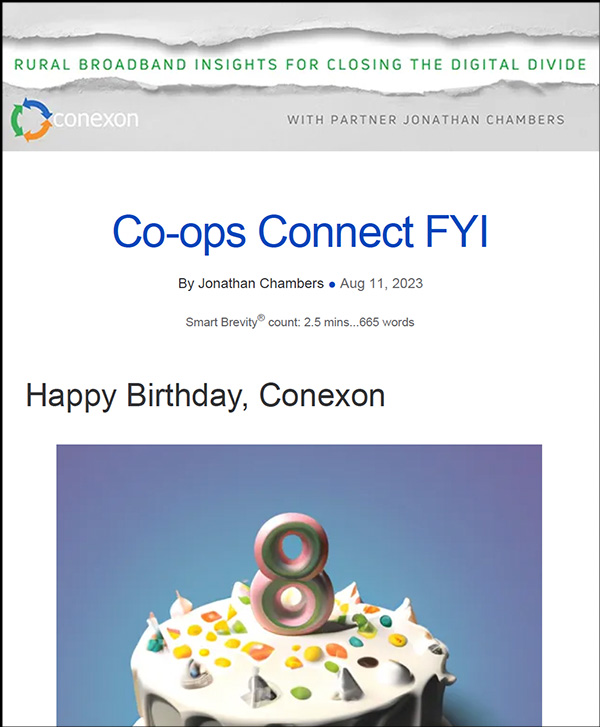Happy Birthday, Conexon!
August 11, 2023
When Randy Klindt first told me the story of Co-Mo Connect, as it was building the nation’s first fiber network to every co-op member, he told me that 80 percent of the Co-Mo membership had been unserved by broadband.
That figure – 80% unserved – was compelling, a level that convinced the Co-Mo management and board to take on the remedial task of doing what the telecommunications industry would not do. Build a fiber network to every member, both the 80% unserved and the 20% served.
Yesterday was Conexon’s 8th birthday. Eight years ago, Randy Klindt submitted to the state of Missouri the articles of incorporation to form Conexon. I joined Randy as his business partner some months later. Over the course of the past eight years, we have conducted fiber feasibility studies for hundreds of electric cooperatives.
- In some cases, like Co-Mo, the membership was 80% or more unserved.
- But in some cases, co-ops took on the task when the membership was already 50% served, or even 80% served.
The simple truth:
- No other type of company has the same organizational structure or geography as an electric cooperative.
- No other type of company will ensure that 100% of the membership would be served with world-class internet service.
- Conexon was formed to follow those same cooperative principles: world-class broadband service to 100% of electric co-op members.
By the numbers
Understanding the Data
The data comes from the FCC’s latest broadband map, which identifies service by speed, technology, and specific location.
- We are using the federal government’s definitions of unserved and underserved from the BEAD program, which means no Internet Service Provider offers 25/3 Mbps (unserved) or 100/20 Mbps (underserved).
- The FCC’s data overstates the levels of service. The data is selfreported, advertised speeds, which is to say, the levels of unserved and underserved are demonstrably higher.
But, at a minimum, the FCC data shows locations across the country that are eligible for BEAD funding.
The Conexon Story
When Randy asked me to join him eight years ago, I expect he believed I could help co-ops get access to public funds. At the time, only incumbent telecommunications companies were eligible for the billions in public funding the FCC spent on rural broadband infrastructure.
Why it matters:
- Over the past eight years, we helped co-ops apply for funds in every federal program and many state programs.
- We organized a bidding consortium of co-ops, called the Rural Electric Cooperative Consortium, which became the largest bidding consortium and largest winning bidder of FCC funds in U.S. history.
- For federal funding, we participated in the CAF II auction, the ReConnect program, CARES Act programs, the RDOF auction, the first and second phases of ARPA programs.
The bottom line: Through it all, the members of the Rural Electric Cooperative Consortium have won billions in state and federal funds.
The Last Train
Now comes BEAD, the largest single concentrated expenditure of public funds on rural broadband infrastructure. After BEAD, there will be other smaller, targeted programs.
As a practical matter, this is the last train.
Even if a co-op is 80% served, management and boards should ask the question: “Who will take care of the remaining 20%? If not us, who will take care of 100% of our membership?”
At times like this, I recall the ancient wisdom of Rabbi Hillel:
If I am not for myself, who will be for me?
If I am not for others, what am I?
If not now, when?
The Final Word
I also recall a lesson I learned when young: one person can make a difference.
Over the past eight years, Randy built a company that employs over 800 people, working on fiber construction across the country, now building over 1,000 miles of fiber cable each week to rural homes and businesses.
Happy birthday, Conexon.
